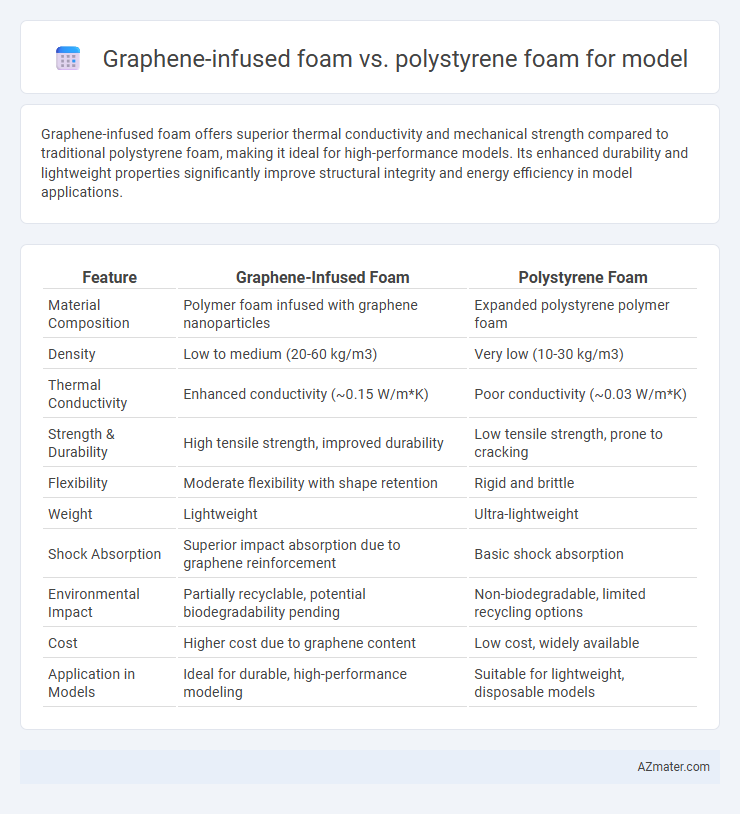Graphene-infused foam offers superior thermal conductivity and mechanical strength compared to traditional polystyrene foam, making it ideal for high-performance models. Its enhanced durability and lightweight properties significantly improve structural integrity and energy efficiency in model applications.
Table of Comparison
| Feature | Graphene-Infused Foam | Polystyrene Foam |
|---|---|---|
| Material Composition | Polymer foam infused with graphene nanoparticles | Expanded polystyrene polymer foam |
| Density | Low to medium (20-60 kg/m3) | Very low (10-30 kg/m3) |
| Thermal Conductivity | Enhanced conductivity (~0.15 W/m*K) | Poor conductivity (~0.03 W/m*K) |
| Strength & Durability | High tensile strength, improved durability | Low tensile strength, prone to cracking |
| Flexibility | Moderate flexibility with shape retention | Rigid and brittle |
| Weight | Lightweight | Ultra-lightweight |
| Shock Absorption | Superior impact absorption due to graphene reinforcement | Basic shock absorption |
| Environmental Impact | Partially recyclable, potential biodegradability pending | Non-biodegradable, limited recycling options |
| Cost | Higher cost due to graphene content | Low cost, widely available |
| Application in Models | Ideal for durable, high-performance modeling | Suitable for lightweight, disposable models |
Introduction to Foam Materials in Modeling
Graphene-infused foam offers enhanced strength, lightweight properties, and superior thermal conductivity compared to traditional polystyrene foam commonly used in modeling. Polystyrene foam provides excellent insulation and is cost-effective but lacks the durability and electrical conductivity that graphene additives bring. Selecting between these materials depends on specific project requirements such as impact resistance, weight constraints, and thermal management.
What is Graphene-Infused Foam?
Graphene-infused foam is a high-performance composite material that incorporates graphene nanoparticles into traditional foam structures, significantly enhancing strength, thermal conductivity, and durability compared to polystyrene foam. This innovative material maintains lightweight properties while offering superior mechanical and electrical conductivity, making it ideal for advanced model applications requiring enhanced stability and precision. Graphene-infused foam's unique combination of flexibility and robustness provides improved impact resistance and environmental sustainability over conventional polystyrene foam.
Understanding Polystyrene Foam Basics
Polystyrene foam, a lightweight and rigid material made from expanded polystyrene beads, offers excellent thermal insulation and shock absorption properties, making it a popular choice for model construction. Its closed-cell structure provides durability and moisture resistance, essential for maintaining the integrity of detailed models. Compared to graphene-infused foam, polystyrene foam lacks enhanced strength and conductivity but remains cost-effective and easy to shape for intricate designs.
Mechanical Strength Comparison
Graphene-infused foam exhibits significantly higher mechanical strength and superior impact resistance compared to traditional polystyrene foam, making it ideal for durable modeling applications. The incorporation of graphene enhances the foam's tensile strength by up to 50%, while maintaining lightweight properties essential for model construction. Polystyrene foam, although cost-effective and easy to shape, falls short in compressive strength and long-term structural integrity when compared to graphene-enhanced alternatives.
Thermal Insulation Capabilities
Graphene-infused foam exhibits superior thermal insulation capabilities compared to polystyrene foam due to graphene's exceptional thermal conductivity and ability to create a dense, uniform structure that minimizes heat transfer. This advanced material reduces thermal bridging and enhances energy efficiency in model applications by maintaining temperature stability over time. Polystyrene foam, while lightweight and cost-effective, offers lower insulation performance, making graphene-infused foam a preferred choice for models requiring high thermal resistance.
Weight and Density Differences
Graphene-infused foam exhibits significantly lower density compared to traditional polystyrene foam, resulting in lighter model components without sacrificing structural integrity. The enhanced material strength of graphene allows for thinner, more compact foam layers, reducing overall weight crucial for precision models and prototypes. Polystyrene foam, while widely used, tends to be denser and heavier, limiting its application in weight-sensitive modeling projects where performance and durability are critical.
Environmental Impact and Sustainability
Graphene-infused foam offers enhanced durability and thermal insulation compared to polystyrene foam, reducing waste through longer product lifespan. Polystyrene foam, a petroleum-based material, poses significant environmental hazards due to its non-biodegradability and difficulty in recycling, leading to persistent landfill accumulation and marine pollution. The integration of graphene in foam composites presents a more sustainable alternative by improving recyclability and reducing carbon footprint during production, aligning with eco-friendly model manufacturing goals.
Cost Analysis: Graphene vs Polystyrene
Graphene-infused foam typically costs significantly more than polystyrene foam due to advanced manufacturing processes and the high price of graphene materials. Polystyrene foam remains the more economical choice for large-scale or budget-sensitive modeling projects, with prices often less than one-tenth that of graphene composites. Despite higher initial costs, graphene-infused foam offers superior strength and durability, potentially reducing long-term replacement expenses compared to polystyrene.
Applications in Scale Model Building
Graphene-infused foam offers superior strength and lightweight properties compared to traditional polystyrene foam, making it ideal for intricate scale model building requiring durability and fine detail. Its enhanced thermal conductivity and resistance to deformation allow for more precise shaping and long-lasting structural integrity in architectural models and prototypes. Polystyrene foam remains popular for its affordability and ease of cutting but lacks the mechanical resilience and advanced performance features critical for high-fidelity, professional-grade scale models.
Future Trends in Foam Technology for Models
Graphene-infused foam offers superior strength-to-weight ratios and enhanced thermal conductivity compared to traditional polystyrene foam, making it a cutting-edge material for models demanding durability and precision. Future trends in foam technology highlight increased integration of nanomaterials like graphene to improve structural performance, resilience, and lightweight properties in architectural, automotive, and aerospace models. Innovations in synthesis techniques and cost reduction are expected to accelerate adoption of graphene-infused foams, driving advancements in sustainable and high-performance model fabrication.

Infographic: Graphene-infused foam vs Polystyrene foam for Model
 azmater.com
azmater.com